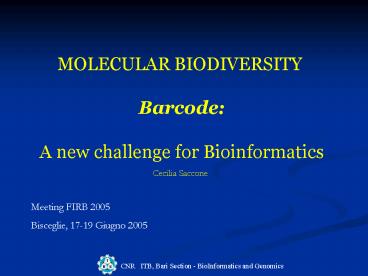MOLECULAR BIODIVERSITY - PowerPoint PPT Presentation
1 / 18
Title:
MOLECULAR BIODIVERSITY
Description:
is a new and exciting tool for characterizing species of organisms of all life ... New species identification (e.g. in medicine, bacteriology, etc) ... – PowerPoint PPT presentation
Number of Views:322
Avg rating:3.0/5.0
Title: MOLECULAR BIODIVERSITY
1
MOLECULAR BIODIVERSITY Barcode A new
challenge for Bioinformatics Cecilia Saccone
Meeting FIRB 2005 Bisceglie, 17-19 Giugno 2005
2
Barcode definition
DNA barcoding is a new and exciting tool for
characterizing species of organisms of all life
forms using a short DNA sequence from a standard
and agreed-upon position in the genome.
3
Consortium for the Barcode of Life (CBOL)
is an international initiative devoted to
developing DNA barcoding http//barcodinglife.or
g/
4
Barcode characteristics
- A candidate DNA barcode should
- be known to be orthologous between specimens
- encompass sufficient variability to allow
discrimination
between species - show low variability within individuals
belonging to the same species.
5
Barcode benefits
- It is a taxonomic identification tool
alternative or additional to morphology - DNA sequencing is a rapid and relatively low
cost technique - Can process a great number of specimens at a
time, thus is useful for example in biodiversity
surveys. - Once reference database is established, it can
be applied by non-specialist.
6
Barcode limitations
- It is not always true that intraspecific
variability is negligible, or at least lower than
interspecific values - There is no universal DNA barcode gene
- Barcode sequences should be generated from type
specimens, thus rely on classical taxonomy
7
Barcode applications
- Biodiversity studies
- New species identification (e.g. in medicine,
bacteriology, etc) - Disease diagnosis (e.g. in veterinary,
parasitology, etc.) - Pest diagnostics in agriculture (e.g in food
farming sciences)
8
Human and common chimpanzee shared a common
ancestor some 6 Mya .
. but their genome sequences are about 98.8
identical (Fuyjiama et al. Science 295, 131-134
2002)
9
Human and mouse diverged from each other
approximately 75 Mya .
. but 40 of their genomes could be aligned at
the nucleotide level. (Boffelli et al., Nature
reviews 5 456-465, 2004)
10
Which sequences are used for DNA barcoding?
- Nuclear small subunit ribosomal RNA gene (SSU)
- Nuclear large subunit ribosomal RNA gene (LSU)
- Internal transcribed spacer section of the
ribosomal RNA cistron (ITS) and the chloroplast
ribulose biphosphate carboxylase large subunit
(rbcL) genes for plants. - Mitochondrial cytochrome c oxidase I gene for
metazoa
11
Why a COI barcode?
- High copy number (100-10000 copies of mt genes vs
2 copies of nuclear genes for each cell) - Recovering mtDNA sequences is easier and cheaper
than nuclear DNA - Greater difference among species (5-10 fold
higher in mt than in nuclear genes). - Few differences among species
- Absence of introns
- mt genes are orthologous in metazoa
12
Barcode studies rely on partial COI
sequences (approximately the first 600 nt of the
gene)
13
COI barcoding the state of the art in
vertebrates
Total number of available COI sequences 5515
Genbank, April 2005
14
COI barcoding a candidate for
inter/intraspecies comparison
Genus Litoria Taxonomic position Amphibia
Batrachia Anura Neobatrachia Hyloidea
Hylidae Pelodryadinae
15
COI barcoding a candidate for
inter/intraspecies comparison
COI complete sequence (as reference) Hyla
chinensis, 1542 nt
Litoria caerulea 1 sequence (556 nt) Litoria
eucnemis 1 sequence (527 nt) Litoria
genimaculata 18 sequences (518-557 nt) Litoria
nannotis 33 sequences (561-578 nt) Litoria
rheocola 30 sequences (549-577 nt) Litoria
serrata 25 sequences (527-575 nt)
Genbank, April 2005
16
COI barcoding inter/intraspecies variability
Genbank, April 2005
17
Barcode standardization
- Standardization lowers costs and lifts
reliability, and thus speeds diffusion and use - Standardization should help accelerate
construction of a comprehensive, consistent
reference library of DNA sequences and
development of economical technologies for
species identification - NCBI is now beta-testing the public submission
tool for the Barcode Section of GenBank. to
submit DNA barcodes data directly to GenBank
should contact Scott Federhen (federhen_at_ncbi.nlm.n
ih.gov).
18
Conclusions
- Anyone, anywhere, anytime will be able to
identify quickly and accurately the species of a
specimen whatever its condition.

